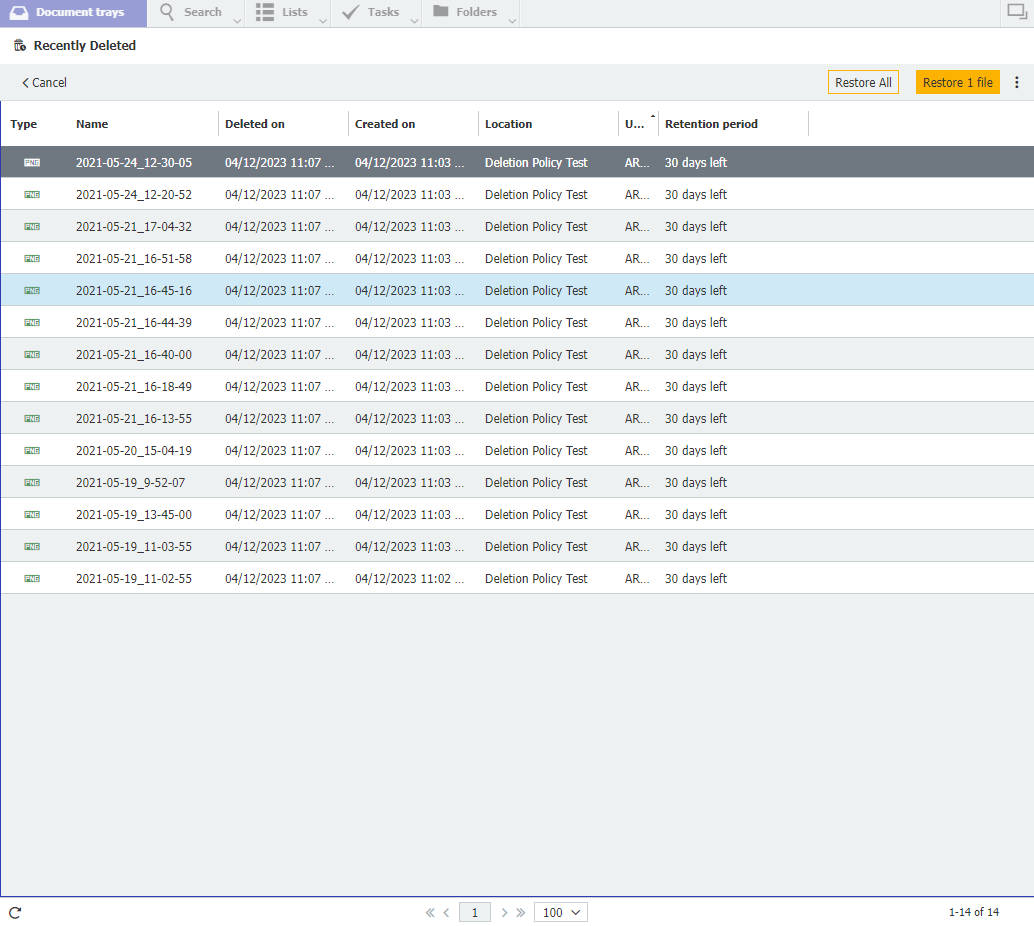Question:
How can we better configure a Deletion Policy to ensure the intended documents are deleted?
How can we better configure a Deletion Policy to ensure the intended documents are deleted?
Solution:
DocuWare Deletion Policy is the ideal method for removing documents from your file cabinets by defining specified rules that determine which documents are removed. While this feature offers an efficient way to remove multiple documents based on a configured ruleset, it is important to understand how these rulesets work to avoid any misunderstandings that can result in the deletion of the incorrect documents. Please refer to the following recommendations for using and configuring a Deletion Policy;
- Upon creating a new Deletion Policy, you are required to select an index or system field that will act as the trigger based on the value associated with it. After selecting your trigger field, you must select an operator and value to further specify your ruleset. Please be aware when selecting these operators and your trigger value, as they can encompass a broad spectrum of documents you may not want to delete if not specified in depth. For example, if you are attempting to delete all the documents with the Account name Peters Engineering the following Deletion Policy rulesets can be created;
Account Name is equal Peters Engineering
Account name contains Engineering
Although both queries will delete all documents with Peters Engineering as the Account name, the query using the Contains operator, which fails to fully specify the intended value, will also delete any document that has Engineering in the Account name within the file cabinet. Before applying any Deletion Policies, understand what type of files are present within the intended file cabinet and be sure to specify a unique trigger. Using a trigger value such as the DocID of a document, for example, will minimize the odds of accidentally impacting other documents within your file cabinet.
- When using a date field, you will notice that you will be given a new set of operators that differ from text and numeric field operators. The date field data type is more frequently used within deletion policies since you can configure a deletion policy to delete documents after a certain timeframe as opposed to using index values. When selecting your operators, please read carefully, as selecting the incorrect option can result in a drastically different outcome than intended. If you are attempting to delete documents that are older than a given time period, you may wonder which operator would be correct to use in this scenario ("After the Past", "Before the Past"). If your organization wishes to delete documents older than 2 years, for example, using the "Before the Past" operator would achieve the intended outcome. If "After the Past" was used in this scenario, the Deletion Policy would delete all documents that are not older than 2 years.

- Before running your Deletion Policy on the intended file cabinet, make a copy of the file cabinet and test the Deletion Policy within the copied file cabinet. This will require you to import some test documents in the copied file cabinet, however, this will demonstrate whether your Deletion Policy runs as desired, or if changes need to be made before applying it to your original file cabinet.
- When configuring a Schedule for the Deletion Policy, please be aware that having a multitude of Deletion Policies and Autoindex jobs running on a "By minute" schedule can affect the performance of your system. To avoid or alleviate this, please increase the schedule intervals on some or all of the active jobs running.
- For organizations on DocuWare 7.8 or higher, if documents are mistakenly deleted, you do have the option to recover these documents. Use the "Recently Deleted" option at the bottom of the DocuWare Web Client. Here, all documents deleted by the Deletion Policy can be recovered.
Note: For Cloud organizations only, if a Deletion Policy is created with the intent to release quota, these files must be manually deleted from the trash can location.

KBA is applicable to both Cloud and On-premise Organizations.


